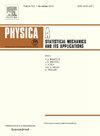Quantum precision measurement using perfect W state via two-body interacting operation
IF 2.8
3区 物理与天体物理
Q2 PHYSICS, MULTIDISCIPLINARY
Physica A: Statistical Mechanics and its Applications
Pub Date : 2025-01-15
DOI:10.1016/j.physa.2024.130300
引用次数: 0
Abstract
We comprehensively investigate the metrological performance of perfect (PW) state in quantum phase measurement, including local operation and two-body interacting operation as the phase generator. The analytical precision limits are obtained in both cases and the decoherence effects are also considered. The results show that under local operation the precision limit is slightly lower than state. In amplitude damping channel the precision limit decreases first and then increases to the shot noise limit, whereas it is always decreased in phase damping channel. Alternatively, the optimal strategies are also provided. In the two-body interacting operations, Ising model and Lipkin–Meshkov–Glick (LMG) model are employed to explore the precision limit. It behaves similar in both cases that with increasing interacting strength the precision limit surpasses the Heisenberg limit for linear phase estimation and gradually converges with state. However, the difference is also evident that the more qubits involved for achieving Heisenberg limit, the larger the needed in Ising model but smaller in LMG model. Interestingly, in amplitude damping channel, with increasing an expanding platform area of precision limit emerges in few-qubit PW state (). This will be beneficial to the stable and tunable high-precision measurement, especially in the noisy circumstances.
求助全文
约1分钟内获得全文
求助全文
来源期刊
CiteScore
7.20
自引率
9.10%
发文量
852
审稿时长
6.6 months
期刊介绍:
Physica A: Statistical Mechanics and its Applications
Recognized by the European Physical Society
Physica A publishes research in the field of statistical mechanics and its applications.
Statistical mechanics sets out to explain the behaviour of macroscopic systems by studying the statistical properties of their microscopic constituents.
Applications of the techniques of statistical mechanics are widespread, and include: applications to physical systems such as solids, liquids and gases; applications to chemical and biological systems (colloids, interfaces, complex fluids, polymers and biopolymers, cell physics); and other interdisciplinary applications to for instance biological, economical and sociological systems.

 求助内容:
求助内容: 应助结果提醒方式:
应助结果提醒方式:


